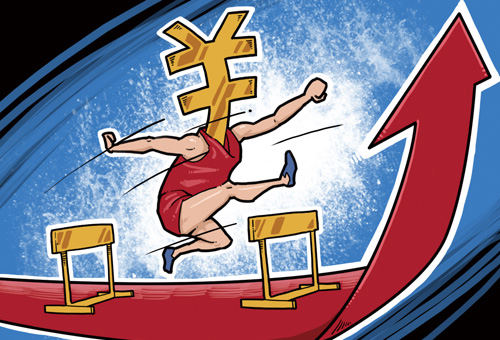|
 |
|
(CFP) |
Seven years have passed since China adopted a floating exchange rate regime based on market supply and demand with reference to a basket of currencies. The Chinese currency, called the yuan or renminbi, has appreciated 22 percent, with the central parity rate of the yuan against the U.S. dollar strengthening from 8.11 on July 21, 2005 to 6.3112 on July 20, 2012.
But the appreciation of the yuan is far from over. Experts think the key to the ongoing exchange rate reform is to allow the market to have a greater role in the process. Meanwhile, expectations of the yuan exchange rate should be stabilized to pave the way for the internationalization of the currency.
Two-way move
Despite the fact that the yuan has appreciated more than 20 percent against the U.S. dollar during the past seven years, it has experienced two-way fluctuations since the fourth quarter of 2011.
In October 2011, the yuan witnessed the first round of depreciation, and now it is again in the midst of another decrease, Ding Zhijie, Dean of School of Banking and Finance at the University of International Business and Economics, told Economic Information Daily.
According to an analysis of renminbi exchange rate trends released by the Shanghai-based Fudan University, in the second quarter of this year the yuan depreciated by 0.88 percent against the U.S. dollar, a record high since 1994. In May, the yuan depreciated by 0.97 percent.
Ding said the two rounds of depreciation have something to do with the rebound of the U.S. dollar in the international market, and to some extent, reflect policy intentions.
During the annual sessions of the National People's Congress and the Chinese People's Political Consultative Conference in March, Premier Wen Jiabao said that since the renminbi exchange rate reform started in 2005, the real effective exchange rate of the yuan has climbed 30 percent. The yuan's exchange rate against the U.S. dollar began fluctuating in the non-delivery forward market of Hong Kong in September 2011, which indicates the yuan exchange rate may be drawing near an equilibrium.
On April 16, the People's Bank of China (PBC), the central bank, widened the trading band for the yuan against the U.S. dollar to 1 percent from 0.5 percent. That means that in the foreign exchange spot market, Chinese banks can exchange the yuan 1 percent above or below the central parity against the U.S. dollar announced by the China Foreign Exchange Trading System each trading day. The PBC extended the trading range of the yuan from 0.3 percent to 0.5 percent in May 2007. Then the range was reduced to 0.3 percent because of the financial crisis. In June 2010, it was again adjusted back to 0.5 percent.
Either at the market level or at the political level, the appreciation pressure on the yuan is decreasing, said Liu Weiming, an expert on financial markets from the head office of China Citic Bank, in an interview with Economic Information Daily. Accompanied by the extension of the floating range, the exchange rate will be more elastic, and the two-way fluctuations will be more evident, he said.
The impact
Accompanying the changes in the yuan exchange rate is the gradually contracting surpluses in the balance of international payments.
| 